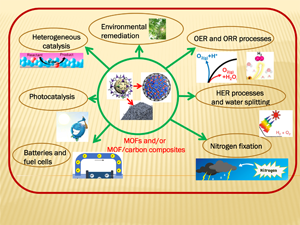Crossref Citations
This article has been cited by the following publications. This list is generated based on data provided by
Crossref.
Pérez-Mayoral, Elena
Matos, Ines
Bernardo, María
Ventura, Marcia
and
Fonseca, Isabel M.
2020.
Carbon-Based Materials for the Development of Highly Dispersed Metal Catalysts: Towards Highly Performant Catalysts for Fine Chemical Synthesis.
Catalysts,
Vol. 10,
Issue. 12,
p.
1407.
Devarayapalli, Kamakshaiah Charyulu
Lee, Jaewon
Kang, Sinwoo
Moon, Sanghyeon
Vattikuti, S.V. Prabhakar
Lee, Jaeyoung
and
Lee, Kiyoung
2022.
Nanostructured cobalt-based metal-organic framework/cadmium sulfide electrocatalyst for enhanced oxygen evolution reaction and anion exchange membrane-based water electrolysis: Synergistic effect.
Journal of Power Sources,
Vol. 527,
Issue. ,
p.
231151.
Quainoo, Timothy
Lavan, Sydney N.
and
Liu, Zhen-Fei
2022.
Van der Waals density functional study of hydrocarbon adsorption and separation in metal–organic frameworks without open metal sites.
Journal of Materials Research,
Vol. 37,
Issue. 1,
p.
334.
Zhang, Wenwen
Zhao, Ximeng
Niu, Weixing
Yu, Hang
Wan, Tongtao
Liu, Guihua
Zhang, Dongsheng
and
Wang, Yanji
2022.
ZIF-67-derived N-doped double layer carbon cage as efficient catalyst for oxygen reduction reaction.
Nanotechnology,
Vol. 33,
Issue. 6,
p.
065409.
Corcho-Valdés, Angel Luis
Iriarte-Mesa, Claudia
Calzadilla-Maya, Jesús
Matos-Peralta, Yasser
Desdín-García, Luis Felipe
and
Antuch, Manuel
2022.
Carbon Composite Catalysts.
p.
223.
Zhang, Chunhua
Pan, Zhiwei
Zhu, Xinru
Jiang, Hong
Chen, Rizhi
and
Xing, Weihong
2022.
Pd Nanoparticles Supported on Hierarchically Porous Carbon Nanofibers as Efficient Catalysts for Phenol Hydrogenation.
Catalysis Letters,
Vol. 152,
Issue. 2,
p.
340.
Nagappan, Saravanan
Duraivel, Malarkodi
Elayappan, Vijayakumar
Muthuchamy, Nallal
Mohan, Balaji
Dhakshinamoorthy, Amarajothi
Prabakar, Kandasamy
Lee, Jae-Myung
and
Park, Kang Hyun
2023.
Metal–Organic Frameworks‐Based Cathode Materials for Energy Storage Applications: A Review.
Energy Technology,
Vol. 11,
Issue. 3,
Qi, Ruiwen
Liu, Xiao
Bu, Hongkai
Niu, Xueqing
Ji, Xiaoyang
Ma, Junwei
and
Gao, Hongtao
2023.
In situ growth of phosphorized ZIF-67-derived amorphous CoP/Cu2O@CF electrocatalyst for efficient hydrogen evolution reaction.
Frontiers of Chemical Science and Engineering,
Vol. 17,
Issue. 10,
p.
1430.
Ansari, Mohammad Numair
Manzoor, Sumaira
khan, Abdul Rauf
Abid, Abdul Ghafoor
Sherif, El-Sayed M.
Ansari, Mohd Zahid
Alamgeer, Muhammad
Ahmad, Naseeb
Khan, Sajjad Ahmad
and
Farid, Hafiz Muhammad Tahir
2023.
Development of MOF-derived zinc carbide-embedded graphitic carbon nitride as an effective nanocomposite for enhanced oxygen evolution reaction.
Chemical Papers,
Vol. 77,
Issue. 11,
p.
6459.
Schlachter, Adrien
Asselin, Paul
Fortin, Daniel
Karsenti, Paul-Ludovic
and
Harvey, Pierre D.
2023.
Strong Host–Guest Dependence on the Emissive Properties of MOF-5 and [Zn2(BTTB)(DMF)2•(H2O)3]n.
Inorganic Chemistry,
Vol. 62,
Issue. 34,
p.
13757.
Kharisov, Boris I.
Kharissova, Oxana V.
González, Lucy T.
Méndez, Yolanda Peña
Uflyand, Igor E.
and
Gómez de la Fuente, Idalia
2024.
Hydroxyapatite composites with carbon allotropes: Preparation, properties, and applications.
Particuology,
Vol. 88,
Issue. ,
p.
239.
Huerta, Gerardo Valadez
Hisama, Kaoru
and
Koyama, Michihisa
2024.
A Comprehensive Computer-Aided Review of Trends in Heterogeneous Catalysis and Its Theoretical Modelling for Engineering Catalytic Activity.
Journal of Chemical Engineering of Japan,
Vol. 57,
Issue. 1,
Kharissova, Oxana V.
González, Lucy T.
Aguilar, Dafne Anahi Carranza
Hernández, Myrthala Garza
Uflyand, Igor E.
Kulkarni, Naveen V.
Méndez, Yolanda Peña
and
Kharissov, Boris I.
2024.
Handbook of Emerging Materials for Sustainable Energy.
p.
147.
Yusibova, Gulnara
Ping, Kefeng
Käärik, Maike
Leis, Jaan
Aruväli, Jaan
Šmits, Krišjānis
Käämbre, Tanel
Kisand, Vambola
Karpichev, Yevgen
Tammeveski, Kaido
and
Kongi, Nadezda
2024.
Optimizing post-treatment strategies for enhanced oxygen reduction/evolution activity in Co–N–C electrocatalyst.
International Journal of Hydrogen Energy,
Vol. 82,
Issue. ,
p.
398.
He, Jun
Wu, Can-Min
and
Chung, Lai-Hon
2024.
Optical and Optoelectronic Polymers.
p.
384.




